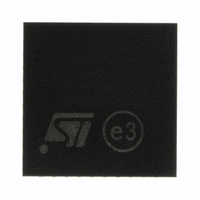SN260Q STMicroelectronics, SN260Q Datasheet - Page 15

SN260Q
Manufacturer Part Number
SN260Q
Description
IC ZIGBEE/802.15.4 PROC 40-QFN
Manufacturer
STMicroelectronics
Datasheet
1.SN260Q.pdf
(47 pages)
Specifications of SN260Q
Frequency
2.4GHz
Modulation Or Protocol
802.15.4
Applications
ZigBee™
Power - Output
-32dBm ~ 5dBm
Sensitivity
-97.5dBm
Voltage - Supply
2.1 V ~ 3.6 V
Current - Receiving
35.5mA
Current - Transmitting
35.5mA
Data Interface
PCB, Surface Mount
Antenna Connector
PCB, Surface Mount
Operating Temperature
-40°C ~ 85°C
Package / Case
40-QFN
For Use With
497-6404 - BOARD EVAL SPZB260 MOD FOR STR9497-5990 - KIT EVAL REVA FOR ZIGBEE497-5879 - NETWORK DEVELOPMENT FOR SN260497-5877 - KIT RADIO CARRIER FOR SN260
Lead Free Status / RoHS Status
Lead free / RoHS Compliant
Memory Size
-
Data Rate - Maximum
-
SN260
6.2
6.2.1
6.2.2
Table 3.
The EmberZNet Software Stack sets the CCA Mode, and it is not configurable by the
Application Layer. For software versions beginning with EmberZNet 2.5.4, CCA Mode 1 is
used, and a busy channel is reported if the RSSI exceeds its threshold. For software
versions prior to 2.5.4, the CCA Mode was set to 0.
At RX input powers higher than –25 dBm, there is some compression in the receive chain
where the gain is not properly adjusted. In the worst case, this has resulted in packet loss of
up to 0.1%. This packet loss can be seen in range testing measurements when nodes are
closely positioned and transmitting at high power or when receiving from test equipment.
There is no damage to the SN260 from this problem. This issue will rarely occur in the field
as ZigBee Nodes will be spaced far enough apart. If nodes are close enough for it to occur
in the field, the MAC and networking software treat the packet as not having been received
and therefore the MAC level and network level retries resolve the problem without needing
to notify the upper level application.
Transmit (TX) path
The SN260 transmitter utilizes both analog circuitry and digital logic to produce the O-QPSK
modulated signal. The area-efficient TX architecture directly modulates the spread symbols
prior to transmission. The differential signal paths increase noise immunity and provide a
common interface for the external balun.
TX baseband
The SN260 TX baseband (within the digital domain) performs the spreading of the 4-bit
symbol into its IEEE 802.15.4-2003-defined 32-chip I and Q sequence. In addition, it
provides the interface for software to perform the calibration of the TX module in order to
reduce process, temperature, and voltage variations.
TX_ACTIVE signal
Even though the SN260 provides an output power suitable for most ZigBee applications,
some applications will require an external power amplifier (PA). Due to the timing
requirements of IEEE 802.15.4-2003, the SN250 provides a signal, TX_ACTIVE, to be used
for external PA power management and RF Switching logic. When in TX, the TX Baseband
drives TX_ACTIVE high (as described
low. If an external PA is not required, then the TX_ACTIVE signal should be connected to
GND through a 100k Ohm resistor, as shown in the application circuit in
The TX_ACTIVE signal can only source 1mA of current, and it is based upon the 1.8V signal
swing. If the PA Control logic requires greater current or voltage potential, then TX_ACTIVE
should be buffered externally to the SN260.
CCA mode
0
1
2
3
CCA mode behavior
Clear channel reports busy medium if either carrier sense OR RSSI exceeds their
thresholds.
Clear channel reports busy medium if RSSI exceeds its threshold.
Clear channel reports busy medium if carrier sense exceeds its threshold.
Clear channel reports busy medium if both RSSI and carrier sense exceed their
thresholds.
inTable
Mode behavior
15). When in RX, the TX_ACTIVE signal is
Functional description
Figure
14.
15/47












